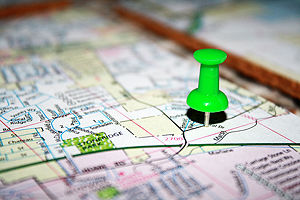Scotland Yard
| Scotland Yard | |
|---|---|

| |
| Designer: | Josh Hadley and others |
| Year: | unknown |
| Players: | 10 to 30 |
| Stuff required: | Walkie talkies, ideally one per player although more or less can be incorporated as necessary. Maps of the play area, with grid references. Torches. Armbands for the hiders. |
| Crew required: | One. |
| Preparation: | Some. |
| Time required: | 3 hours + |
| Place required: | Large outdoors area. |
| Activities: | Running, hiding, chasing, sneaking |
| This is an unfinished game. It is still in the design stage, and is not playable. | |
| This game is made available under an Attribution-Noncommercial Creative Commons licence. (What does this mean?) | |
Scotland Yard is a hide-and-seek game based loosely on the board game of the same name (published by Milton Bradley in English and Ravensburger in German). The rules here are highly embryonic.
The game is usually played at night, although a daytime variant is available.
Preparation
The majority of the players are seekers. A small number are the hiders. A ratio of 4 seekers for every hider works nicely.
Ideally, each player needs a walkie-talkie. If walkie-talkies are in short supply, then seekers can band together in small groups, but the hiders need to have one each. For best results, the hiders' talkies should be set to a different frequency from that of the seekers, although in that situation one of the seekers will need one talkie on each frequency. In extremis, mobile phones are an acceptable substitute, providing that everyone playing is happy to use their credit in this way.
The play area will need to be defined in advance and maps with grid references (the size of the grid depending on the size of the play area) will need to be produced, with one copy for each player. The size of the play area depends on not just the number of players, but also how familiar with the area the players are; for 15-20 players in their home town, a square mile is adequate, although this should be scaled up for more players or scaled down for unfamiliar surroundings.
The seekers will also need torches, as this is ideally a night game. The hiders all need to wear armbands for identification, although the seekers do not. The best time to start playing is about 1am, when the streets are nice and quiet.
Play
Every 5 minutes, the hiders must radio the seekers to tell them the grid reference of the location in which he or she was five minutes previously. The hider needs to keep track of this information, so players are encouraged to keep track of their movements on their maps. Using this information, the seekers must find the hiders in the time-honoured fashion. The hiders may not go indoors, use public transport or violate private property (although that last one tends to get broken a lot.)
Daytime alternative
Alternatively, the game can be played with fewer players, over a smaller area, during the day. The core mechanics would stay the same.
Victory
There are a number of plausible victory conditions.
- Survival - give the game a time limit. A seeker who tags a hider becomes a hider in their place. Victory is based on who spent most of the game as a hider.
- Safehouse - The hiders have a safe-house that they have to reach. Seekers are not permitted to guard the safehouse.
- Kevan comments:
- "Seekers are not permitted to guard the safehouse" seems tricky to play fairly, as a seeker - it probably needs to be a large, multi-entrance "safe zone", like in Journey. (Either that or the game has a bunch of possible safehouses, and the hiders are somehow randomly assigned one at the start. Maybe hand out cards, pick one at random and visibly destroy the others without the seekers ever seeing them - the hiders show the card at the end of the game.)
- An interesting variant on this was a game where the safehouse was a car, and thus mobile, which had to radio its previous location to the hiders every 15 minutes or so, without the seekers ever knowing exactly where it was.
- Scavenger hunt - Similarly to Safehouse, the hiders have a number of items that they have to find without the seekers finding them. When the hiders collectively have all of the items that they need, they have won.
Which victory condition to use really depends on how many players their are, how structured you want the game to be, and how long you want to play for. Equally acceptable is to just keep on going, changing the hiders whenever they get caught, until everyone is too tired to continue.
Problems, suggestions, work points
- A GM-esque role, keeping track of the locations of both groups of players and dishing out information as necessary - worthwhile? Necessary?
Flickr photos
<flickr size="m">ludocity%3Agame%3Dscotlandyard</flickr>
(These are the ten most recent Flickr photos of Scotland Yard. To add your own, just add the "ludocity:game=scotlandyard" tag to your Flickr photos.)
See also
- Mister X Sat Radio, another pervasive game based on the same boardgame